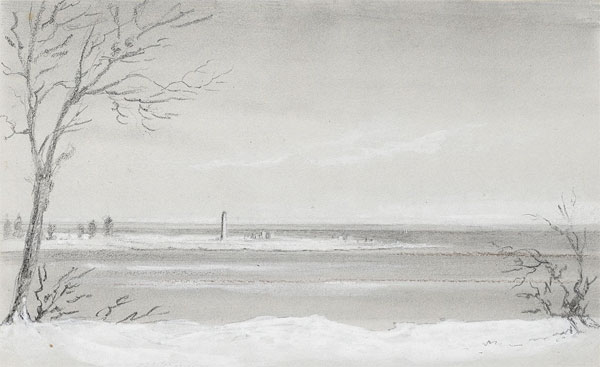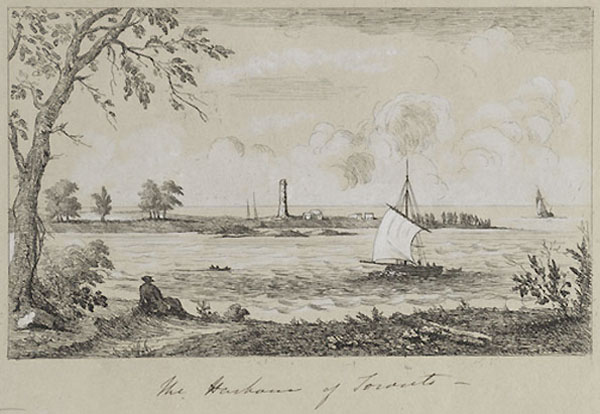One of my favourite primary sources for old Toronto history is Anna Jameson’s diary, Winter Studies and Summer Rambles in Canada. She was a British writer and feminist who spent the winter of 1836-37 living here. She was in town to visit — and get a separation from — her husband, Robert Jameson, the Attorney General of Upper Canada. They lived down by the lake, and he’d later own land where Parkdale is now. Jameson Avenue is named after him. That’s her sketch of the harbour I’ve posted above. The view included the edge of the islands and the Gibraltar Point Lighthouse, which is still standing there today, nearly 200 years later.
Anna Jameson wasn’t exactly a fan of Toronto during the winter… for all the obvious reasons. The first entry she made in her diary after arriving in the fledgling city of about five thousand people was far from a glowing review. It was December:
“What Toronto may be in summer, I cannot tell; they say it is a pretty place. At present its appearance to me, a stranger, is most strangely mean and melancholy. A little ill-built town, on low land, at the bottom of a frozen bay, with one very ugly church, without tower or steeple; some government offices, built of staring red brick, in the most tasteless, vulgar style imaginable; three feet of snow all around; and the grey, sullen, wintry lake, and the dark gloom of the pine forest bounding the prospect: such seems Toronto to me now. I did not expect much; but for this I was not prepared.”
She spent most of the winter making similarly miserable entries in her diary. They’re full of snowstorms and sleet. One night, she writes that the ink is freezing in her pen and her fingers are growing stiff with cold. By morning, even her fireplace is a block of ice. Words like “dreary” and “monotonous” and “desolation” keep coming up. She’d later call it “the relentless iron winter.” By the time January rolled around, she was having the kind of thoughts familiar to many Torontonians:
“I could almost wish myself a dormouse, or a she-bear, to sleep away the rest of this cold, cold winter, and wake only with the first green leaves, the first warm breath of the summer wind. I shiver through the day and through the night; and, like poor Harry Gill, ‘my teeth they chatter, chatter still.'”
The cold weather carried on into April that year. For the first two weeks of the month, the lake was still covered in ice. But then, 176 years ago yesterday — April 15, 1837 — Jameson wrote that spring had finally come to the city:
“The ice in the Bay of Toronto has been, during the winter months, from four to five feet in thickness: within the last few days it has been cracking in every direction with strange noises, and last night, during a tremendous gale from the east, it was rent, and loosened, and driven at once out of the bay… The last time I drove across the bay, the ice beneath me appeared as fixed and firm as the foundations of the earth, and within twelve hours it has disappeared, and to-day the first steam-boat of the season entered our harbour. They called me to the window to see it, as, with flags and streamers flying, and amid the cheers of the people, it swept majestically into the bay. I sympathised with the general rejoicing, for I can fully understand all the animation and bustle which the opening of the navigation will bring to our torpid capital.”
It was, of course, just the beginning. Over the course of the next month, as the weather slowly improved and flowers bloomed, Toronto began to work its way into Anna Jameson’s heart. By the middle of May, her tone had very much changed:
“This beautiful Lake Ontario!—my lake—for I begin to be in love with it, and look on it as mine!—it changed its hues every moment, the shades of purple and green fleeting over it, now dark, now lustrous, now pale—like a dolphin dying; or, to use a more exact though less poetical comparison, dappled, and varying like the back of a mackerel, with every now and then a streak of silver light dividing the shades of green: magnificent, tumultuous clouds came rolling round the horizon; and the little graceful schooners, falling into every beautiful attitude, and catching every variety of light and shade, came curtseying into the bay: and flights of wild geese, and great black loons, were skimming, diving, sporting over the bosom of the lake; and beautiful little unknown birds, in gorgeous plumage of crimson and black, were fluttering about the garden: all life, and light, and beauty were abroad—the resurrection of Nature! How beautiful it was! how dearly welcome to my senses—to my heart—this spring which comes at last—so long wished for, so long waited for!”
A month later, she was complaining about the heat.
A version of this post originally appeared on The Toronto Dreams Project Historical Ephemera Blog.
Images from Anna Jameson’s sketchbook, via The Toronto Arts Foundation’s website.





One comment
She sounds like she was a true Torontonian from the moment she arrived!